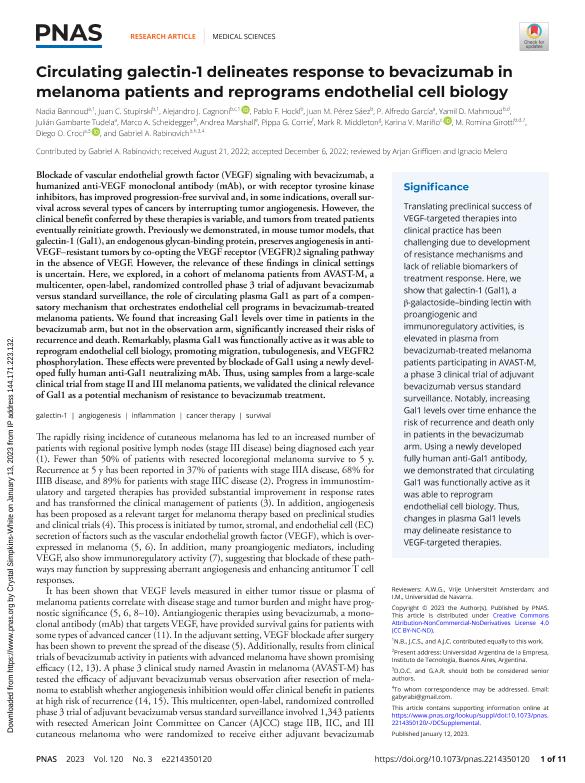Artículo
Circulating galectin-1 delineates response to bevacizumab in melanoma patients and reprograms endothelial cell biology
Bannoud, Nadia ; Stupirski, Juan Carlos
; Stupirski, Juan Carlos ; Cagnoni, Alejandro
; Cagnoni, Alejandro ; Hockl, Pablo Francisco
; Hockl, Pablo Francisco ; Pérez Sáez, Juan Manuel
; Pérez Sáez, Juan Manuel ; García, Pablo Alfredo
; García, Pablo Alfredo ; Mahmoud, Yamil Damián
; Mahmoud, Yamil Damián ; Gambarte Tudela, Julian Alberto
; Gambarte Tudela, Julian Alberto ; Scheidegger, Marco Adrian
; Scheidegger, Marco Adrian ; Marshall, Andrea; Corrie, Pippa G.; Middleton, Mark R.; Mariño, Karina Valeria
; Marshall, Andrea; Corrie, Pippa G.; Middleton, Mark R.; Mariño, Karina Valeria ; Girotti, Maria Romina
; Girotti, Maria Romina ; Croci Russo, Diego Omar
; Croci Russo, Diego Omar ; Rabinovich, Gabriel Adrián
; Rabinovich, Gabriel Adrián
 ; Stupirski, Juan Carlos
; Stupirski, Juan Carlos ; Cagnoni, Alejandro
; Cagnoni, Alejandro ; Hockl, Pablo Francisco
; Hockl, Pablo Francisco ; Pérez Sáez, Juan Manuel
; Pérez Sáez, Juan Manuel ; García, Pablo Alfredo
; García, Pablo Alfredo ; Mahmoud, Yamil Damián
; Mahmoud, Yamil Damián ; Gambarte Tudela, Julian Alberto
; Gambarte Tudela, Julian Alberto ; Scheidegger, Marco Adrian
; Scheidegger, Marco Adrian ; Marshall, Andrea; Corrie, Pippa G.; Middleton, Mark R.; Mariño, Karina Valeria
; Marshall, Andrea; Corrie, Pippa G.; Middleton, Mark R.; Mariño, Karina Valeria ; Girotti, Maria Romina
; Girotti, Maria Romina ; Croci Russo, Diego Omar
; Croci Russo, Diego Omar ; Rabinovich, Gabriel Adrián
; Rabinovich, Gabriel Adrián
Fecha de publicación:
01/2023
Editorial:
National Academy of Sciences
Revista:
Proceedings of the National Academy of Sciences of The United States of America
ISSN:
0027-8424
Idioma:
Inglés
Tipo de recurso:
Artículo publicado
Clasificación temática:
Resumen
Blockade of vascular endothelial growth factor (VEGF) signaling with bevacizumab, a humanized anti-VEGF monoclonal antibody (mAb), or with receptor tyrosine kinase inhibitors, has improved progression-free survival and, in some indications, overall survival across several types of cancers by interrupting tumor angiogenesis. However, the clinical benefit conferred by these therapies is variable, and tumors from treated patients eventually reinitiate growth. Previously we demonstrated, in mouse tumor models, that galectin-1 (Gal1), an endogenous glycan-binding protein, preserves angiogenesis in anti-VEGF-resistant tumors by co-opting the VEGF receptor (VEGFR)2 signaling pathway in the absence of VEGF. However, the relevance of these findings in clinical settings is uncertain. Here, we explored, in a cohort of melanoma patients from AVAST-M, a multicenter, open-label, randomized controlled phase 3 trial of adjuvant bevacizumab versus standard surveillance, the role of circulating plasma Gal1 as part of a compensatory mechanism that orchestrates endothelial cell programs in bevacizumab-treated melanoma patients. We found that increasing Gal1 levels over time in patients in the bevacizumab arm, but not in the observation arm, significantly increased their risks of recurrence and death. Remarkably, plasma Gal1 was functionally active as it was able to reprogram endothelial cell biology, promoting migration, tubulogenesis, and VEGFR2 phosphorylation. These effects were prevented by blockade of Gal1 using a newly developed fully human anti-Gal1 neutralizing mAb. Thus, using samples from a large-scale clinical trial from stage II and III melanoma patients, we validated the clinical relevance of Gal1 as a potential mechanism of resistance to bevacizumab treatment.
Palabras clave:
ANGIOGENESIS
,
CANCER THERAPY
,
GALECTIN-1
,
INFLAMMATION
,
SURVIVAL
Archivos asociados
Licencia
Identificadores
Colecciones
Articulos(IBYME)
Articulos de INST.DE BIOLOGIA Y MEDICINA EXPERIMENTAL (I)
Articulos de INST.DE BIOLOGIA Y MEDICINA EXPERIMENTAL (I)
Articulos(IHEM)
Articulos de INST. HISTOLOGIA Y EMBRIOLOGIA DE MEND DR.M.BURGOS
Articulos de INST. HISTOLOGIA Y EMBRIOLOGIA DE MEND DR.M.BURGOS
Citación
Bannoud, Nadia; Stupirski, Juan Carlos; Cagnoni, Alejandro; Hockl, Pablo Francisco; Pérez Sáez, Juan Manuel; et al.; Circulating galectin-1 delineates response to bevacizumab in melanoma patients and reprograms endothelial cell biology; National Academy of Sciences; Proceedings of the National Academy of Sciences of The United States of America; 120; 3; 1-2023; 1-11
Compartir
Altmétricas



